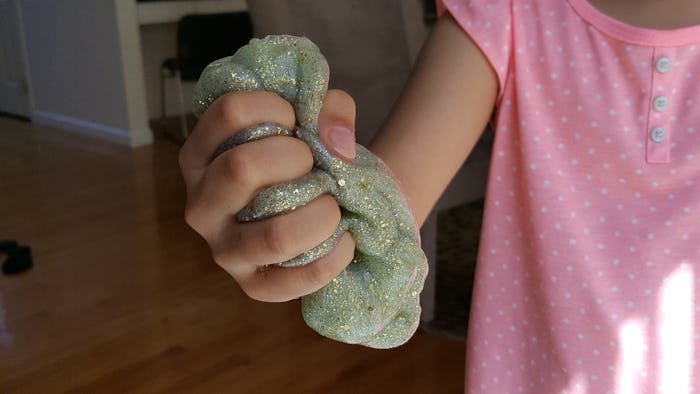Life

Here's How To Fix Your Slime If It's Just Too Rubbery
As a mom of a 9-year-old, I know all too well the roller coaster of fads that kids go through on a weekly basis. To my surprise, slime making is one of those fads that actually stuck (pun intended), and over two years, my daughter has legitimately become a slime expert. If you are crafting slime with your kids, you need to make sure you use the right ingredients in the right proportions, or it may not turn out to bouncy rather than slimy. If this happens to you, you should know what do when your slime is too rubbery.
For some expert insight, I reached out to my resident slime expert, Anusheh Zafar, who says that slime can end up rubbery if your activator is too strong, so you need add some kind of deactivator. “If you have used too much borax, detergent, or liquid starch to your slime it will end up feeling like rubber,” says Zafar, “so you need to soften it up with either hair gel, lotion, or a little bit of warm water.”
So how do know that your slime is too rubbery? Zafar says that if you somehow end up over activating your slime, when you knead it it will be very sticky and will rip as you work it. She explains that rubbery slime doesn't really stretch too well, and even when you are done kneading it, it may just break apart when you pull it. If you aren’t in the mood to fix your slime, you can actually just leave it the way it is. “Sometimes I keep my slime rubbery,” adds Zafar, “because it turns into a great squishy stress relief slime.” If you have the patience, she says you can funnel your rubbery slime into an empty balloon and turn it into a stress reliever.
If you are looking for a foolproof, simple slime recipe, Zafar says you can combine 4 ounces of Elmer’s glue (she says Elmer’s works best) with 2 to 3 tablespoons of liquid starch. If you want the slime to be clear, she says you can mix a teaspoon of baking soda with 3 tablespoons of contact lens solution, and then combine the liquid mixture to 4 ounces of clear Elmer’s glue. For colored slime, she suggests adding your color to the glue beforehand. “Keep in mind that clear glue activates slower than opaque glue,” adds Zafar, “so you may need to knead it longer and add extra contact lens solution if needed."
The most appealing thing about crafting slime seems to be the creativity and experimentation involved, and you can add pretty much anything to your slime to make it more fun. There are thousands of different variations and recipes for slime on the internet, and Zafar says that some slimes are even meant to be rubbery. Cloud slime and diaper slime (yes, really) are two slightly rubbery versions, she notes, and because they require additives like fake snow and diaper fluff, over-action is required to balance out the consistency. If you’re interested in trying these versions out, Zafar recommends checking out this Cloud Slime Recipe from Just Ameerah, or this Diaper Slime Recipe from Crafty Girls on YouTube.
It looks like the slime craze isn’t going anywhere for now, and stores are stocking up on more slime making ingredients day by day. As a parent, I can’t complain. Slime crafting keeps my kid engaged, nurtures her creativity, and keeps her from becoming a screen zombie. I think this fad is a great excuse for parents to spend some quality time with their kids, and it provides a fun and productive activity that everyone can enjoy.
Check out Romper's new video series, Bearing The Motherload, where disagreeing parents from different sides of an issue sit down with a mediator and talk about how to support (and not judge) each other’s parenting perspectives. New episodes air Mondays on Facebook.